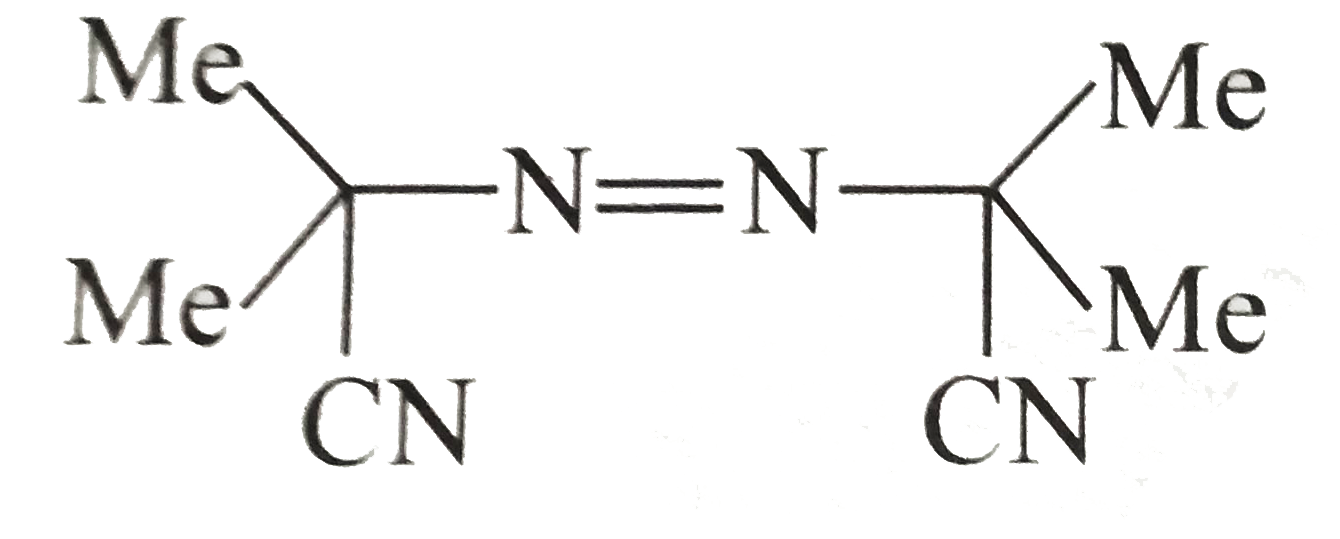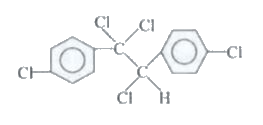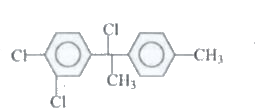An alkyl halide is reduced to the corresponding alkane by tributyl stannane (C4H9)3SnH and by a free radical menchanism in the presence of an initiator, an azo compound

that breaks down to N2 and a radical. Give the mechanism of the reaction.

Chain-propagation step:
(C4H9)3Sn+R−−−X→(C4H9)3Sn−−−X+R
R+(C4H9)3Sn−−−−H→RH+(C4H9)3Sn
Topper's Solved these Questions
- ALKANES AND CYCLOALKANESBOOK - CENGAGE CHEMISTRY ENGLISHCHAPTER - ALKANES AND CYCLOALKANESEXERCISE - Paragraph for problem
24 Videos
- ALKANES AND CYCLOALKANESBOOK - CENGAGE CHEMISTRY ENGLISHCHAPTER - ALKANES AND CYCLOALKANESEXERCISE - True and False
1 Video
- ALKANES AND CYCLOALKANESBOOK - CENGAGE CHEMISTRY ENGLISHCHAPTER - ALKANES AND CYCLOALKANESEXERCISE - SOLVED EXAMPLES
19 Videos
- ALKENES AND ALKADIENESBOOK - CENGAGE CHEMISTRY ENGLISHCHAPTER - ALKENES AND ALKADIENESEXERCISE - Single correct Answer
14 Videos
Similar Questions
When a mixture of 2-merthyl propane and CC14 is reacted at 403-413 in the presence of a radical intiator, t-butyl peroxide, 2-chloro-2-methyl propane and chloroform (CHC13 are formed. Give the mechanism of the reaction.
View SolutionThree compounds A,B and C all have molecular formula C5H8 All the compound rapidly decolourise Br2 in CCl4. All three give a position test with Baeyer's reagent. And all the three are soluble in cold conc. H2SO4. Compound A gives a precipitate when treated with ammonical AgNO3 solution. but compounds B and C do not compounds A and B both yield pentane (C5H12) when they are treated with excess H2 in the presence of Pt catalyst. Under these conditions, compound C absorbs only one mole of H2 and gives a product with the formula C5H10 On oxidation with hot acidified KMnO_4, B gave acetic acid and CH_3CH_2COOH. Identify compounds A, B, and C.
View Solution
Knowledge Check
The insecticide DDT (C14H9Cl)5 is prepared by heating chlorobenzene with chloral (CCl3CHO) in the presence of conc. H2SO4. Which of following compounds is DDT ?
A B
B C
C D
D
A compounds X is fromed by the reaction of a carboxylic acid C2H4O2 and an alcohol in the presence of a few drops of H2SO4. The alcohol on oxidation with alkalne KMnO4 followed by acidification gives the same carboxylic as used in this reaction. Give the names and structures of (a) carboxylic acid, (b) alcohol and (c ) the compound X. Also write the reaction.
View SolutionAn aliphatic unsaturated hydrocarbon (A) when treated with HgS∅H2SO4 yields a compound (B) having molecular formula C3H6O. (B) on oxidation with concentrated HNO3 gives two compounds (C) and (D). Compound (C) when treated with PCl5 gives compound (E). (E) when reacts with ethanol gives a sweet-smelling liquid (F). Compound (F) is also formed when (C) reacts with ethanol in the presence of concentrated H2SO4.
(i) Identify the compound A, B, C, D, E and F.
(ii) Give the chemical equation for the reaction of (C) with chlorine in the presence of red phosphorus and name the reaction.
View SolutionAn aliphatic unsaturated hydrocarbon (A) when treated with HgSO4/H2SO4 yields a compound (B) having molecular formula C3H6O. (B) on oxidation with concentrated HNO3 gives two compounds ( C ) and (D). Compound (C ) when treated with PCl5 gives compound (E ). (E ) when reacts with ethanol gives a sweet smelling liquid (F). Compound (F) is also formed when (C ) reacts with ethanol in the presence of concentrated H2SO4.
(i) Identify the compound A, B, C, D, E and F.
(ii) Give the chemical equation for the reaction of ( C ) with chlorine in the presence of red phosphorus and name the reaction.
View SolutionA compound 'A' when treated with HNO3 (in presence of H2SO4) gives compound B, which is the reduced with Sn and HCl to aniline ? The compound 'A' is
View SolutionCH3CO2C2H5 on reaction with sodium ethoxide in ethanol gives A, which on heating in the presence of acid gives B compound B is
View SolutionAn organic compound A with molecular formula C2H7N on reaction with nitrous acid gives a compound B.B on controlled oxidation gives a compound C. C reduces Tollens' reagent to give silver mirror and D. B reacts with D in the presence of concentrated sulfuric acid to give a sweet smelling compound E. Identify A, B, C, D and E. Give the reaction of C with ammonia and name the product.
View SolutionRead the given passage and answer the questions number 1 to 5 that follow:
The substitution reaction of alkyl halide mainly occurs by SN1 and SN2 mechanism. Whatever mechanism alkyl halides follow for the substitution reaction to occur, the polarity of the carbon halogen bond is responsible for these substitution reactions. The rate of SN1 reactions are governed by the stability of carbocation whereas for SN2 reactions steric factor is the deciding factor. If the starting material is a chiral compound, we may end up with an inverted product or racemic mixture depending upon the type of mechanism followed by alkyl halide. Cleavage of ethers with HI also governed by steric factor and stability of carbocation, which indicates that in organic chemistry, these two major factors help us in deciding the kind of product formed
1. Predict the stereochemistry of the product formed if an optically active alkyl halide undergoes substitution reaction by SN1 mechanism.
2. Name the instrument used for measuring the angle by which the plane polarised light is rotated.
3. Predict the major product formed when 2-Bromopentane reacts with alcoholic KOH.
4. Give one use of CHI3
5. Write the structures of the products formed when anisole is treated with HI.
View Solution